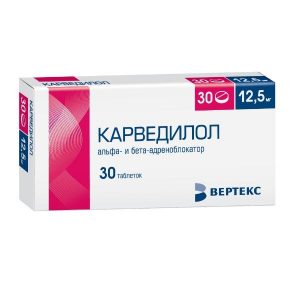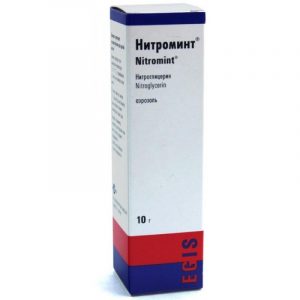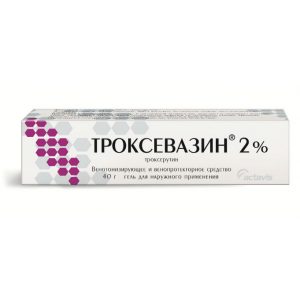Description
Release form
Tablets
Packaging
20 pcs
Pharmacological action
Pharmacotherapeutic group:
Angiotensin-converting enzyme (ACE) inhibitor
Pharmacodynamics:
Enalapril is an antihypertensive drug from the group of ACE inhibitors. Enalapril is a “prodrug”: as a result of its hydrolysis, enalaprilat is formed, which inhibits ACE. The mechanism of its action is associated with a decrease in the formation of angiotensin II from angiotensin I, a decrease in the content of which leads to a direct decrease in the release of aldosterone. This decreases the overall peripheral vascular resistance, systolic and diastolic blood pressure (BP), post – and myocardial preload.
Expands arteries to a greater extent than veins, with no reflex increase in heart rate.
The antihypertensive effect is more pronounced with a high level of plasma renin than with a normal or reduced level. A decrease in blood pressure within the therapeutic range does not affect cerebral circulation, blood flow in the vessels of the brain is maintained at a sufficient level and against the background of lowered blood pressure. Enhances coronary and renal blood flow.
With prolonged use, hypertrophy of the left ventricle of the myocardium and myocytes of the walls of the arteries of the resistive type, prevents the progression of heart failure and slows down the development of dilatation of the left ventricle. Improves blood supply to the ischemic myocardium. Reduces platelet aggregation.
Has some diuretic effect.
The time of onset of the hypotensive effect when taken orally is 1 hour, reaches a maximum after 4-6 hours and lasts up to 24 hours. Some patients require therapy for several weeks to achieve the optimal level of blood pressure. With heart failure, a noticeable clinical effect is observed with prolonged treatment – 6 months or more.
Pharmacokinetics: After oral administration, 60% of the drug is absorbed. Eating does not affect the absorption of enalapril.
Enalapril up to 50% binds to plasma proteins. Enalapril is rapidly metabolized in the liver to form an active metabolite of enalaprilat, which is a more active ACE inhibitor than enalapril. The bioavailability of the drug is 40%.
The maximum concentration of enalapril in blood plasma is reached after 1 hour, enalaprilat – 3-4 hours. Enalaprilat easily passes through the histohematological barriers, except for the blood-brain barrier, a small amount penetrates the placenta and into breast milk.
The half-life of enalaprilat is about 11 hours. Enalapril is excreted mainly by the kidneys – 60% (20% – as enalapril and 40% – as enalaprilat), through the intestines – 33% (6% – as enalapril and 27% – as enalaprilat )
Removed during hemodialysis (rate 62 ml / min) and peritoneal dialysis.
Indications
– arterial hypertension
– chronic heart failure (as part of combination therapy).
Contraindications
Hypersensitivity to enalapril and other ACE inhibitors, history of angioedema associated with treatment with ACE inhibitors, as well as hereditary or idiopathic angioedema, pregnancy, lactation, and safety (under 18 years).
Use with caution in case of primary hyperaldosteronism, bilateral renal artery stenosis, single kidney artery stenosis, hyperkalemia, condition after kidney transplantation, aortic stenosis, mitral stenosis (with hemodynamic impairment), idiopathic hypertrophic subaortic stenosis of the heart, systemic disease diseases diabetes mellitus, renal failure (proteinuria more than 1 g / day), liver failure, in patients on a salt-restricted diet or on hemodialysis, while taking it with immunosuppressants and saluretics, in older people (over 65), bone marrow suppression hematopoiesis conditions accompanied by a decrease in the volume of circulating blood (including diarrhea, vomiting).
Special instructions
Caution must be exercised when prescribing to patients with reduced circulating blood volume (as a result of diuretic therapy, while limiting salt intake, hemodialysis, diarrhea and vomiting), the risk of sudden and pronounced decrease in blood pressure after applying even an initial dose of an ACE inhibitor is increased . Transient arterial hypotension is not a contraindication to continue treatment with the drug after stabilization of blood pressure (BP). In the case of a repeated marked decrease in blood pressure, the dose should be reduced or the drug should be discontinued.
The use of high-strength dialysis membranes increases the risk of anaphylactic reactions. Correction of the dosage regimen on days free of dialysis should be carried out depending on the level of blood pressure.
Before and during treatment with ACE inhibitors, periodic monitoring of blood pressure, blood counts (hemoglobin, potassium, creatinine, urea, activity of liver enzymes), protein in the urine is necessary.
Carefully monitor patients with severe chronic heart failure, coronary heart disease, and cerebrovascular diseases in whom a sharp decrease in blood pressure can lead to myocardial infarction, stroke, or impaired renal function.
Sudden cancellation of treatment does not lead to the development of rebound syndrome (a sharp increase in blood pressure).
It is recommended to carefully monitor newborns and infants who have been exposed to intrauterine exposure to ACE inhibitors to timely detect a pronounced decrease in blood pressure, oliguria, hyperkalemia and neurological disorders, possible due to a decrease in renal and cerebral blood flow with a decrease in blood pressure caused by ACE inhibitors. In oliguria, it is necessary to maintain blood pressure and renal perfusion by introducing appropriate fluids and vasoconstrictors.
Before researching the functions of the parathyroid glands should be discontinued.
Alcohol enhances the hypotensive effect of the drug.
At the beginning of treatment, before the completion of the dose selection period, it is necessary to refrain from driving vehicles and engaging in potentially dangerous activities that require an increased concentration of attention and speed of psychomotor reactions, as dizziness is possible, especially after an initial dose of an ACE inhibitor in patients taking diuretics.
Before surgery (including dentistry), the surgeon / anesthetist should be advised of the use of ACE inhibitors.
Composition
1 tablet contains the active substance enalapril maleate 5 mg, 10 mg.
Excipients:
corn starch,
lactose (milk sugar),
microcrystalline cellulose,
silicon dioxide colloidal (Aerosil A-300),
calcium stearate.
Dosage and administration
Assign inside, regardless of the meal time. To ensure the dosage regimen below, it is possible to use the drug enalapril in a dose of 2.5 mg.
In monotherapy of arterial hypertension – the initial dose of 5 mg 1 time per day.
In the absence of a clinical effect, the dose is increased by 5 mg after 1-2 weeks. After taking the initial dose, patients should be under medical supervision for 2 hours and an additional 1 hour until blood pressure stabilizes. If necessary and sufficiently good tolerance, the dose can be increased to 40 mg / day. in 2 doses. After 2-3 weeks, they switch to a maintenance dose of 10-40 mg / day, divided into 1-2 doses. With moderate arterial hypertension, the average daily dose is about 10 mg.
The maximum daily dose of the drug is 40 mg / day.
In case of administration to patients simultaneously receiving diuretics, treatment with a diuretic must be stopped 2-3 days before the appointment of enalapril-FPO®. If this is not possible, then the initial dose of the drug should be 2.5 mg / day.
Patients with hyponatremia (serum sodium ion concentration less than 130 mmol / L) or serum creatinine concentration more than 0.14 mmol / L, the initial dose is 2.5 mg once a day.
In case of renovascular hypertension, the initial dose is 2.5 – 5 mg / day. The maximum daily dose is 20 mg.
In chronic heart failure, the initial dose is 2.5 mg once, then the dose is increased by 2.5 – 5 mg every 3-4 days in accordance with the clinical response to the maximum tolerated dose depending on the blood pressure, but not higher than 40 mg / day once or in 2 divided doses. In patients with low systolic blood pressure (less than 110 mm Hg), therapy should be started with a dose of 1.25 mg. Dose selection should be carried out within 2-4 weeks. or in a shorter time. The average maintenance dose is 5 -20 mg / day. for 1-2 doses.
In elderly patients, a more pronounced hypotensive effect and an increase in the duration of the drug s action are more often observed, which is associated with a decrease in the rate of enalapril excretion, so the recommended initial dose for the elderly is 1.25 mg.
In chronic renal failure, cumulation occurs with a decrease in filtration of less than 10 ml / min. With creatinine clearance (CC) of 80-30 ml / min, the dose is usually 5-10 mg / day., With CC up to 30-10 ml / min. – 2.5 – 5 mg / day., With CC less than 10 ml / min. – 1.25 – 2.5 mg / day. only on dialysis days.
The duration of treatment depends on the effectiveness of the therapy. With a too pronounced decrease in blood pressure, the dose of the drug is gradually reduced.
The drug is used both in monotherapy and in combination with other antihypertensive drugs.
Side effects
Enalapril-FPO ® is generally well tolerated and in most cases does not cause side effects, requiring withdrawal of the drug.
From the cardiovascular system: excessive decrease in blood pressure, orthostatic collapse, rarely chest pain, angina pectoris, myocardial infarction or stroke (usually associated with a marked decrease in blood pressure), extremely rare arrhythmias (atrial brady or tachycardia, atrial fibrillation), palpitations, thromboembolism of the branches of the pulmonary artery, Raynaud’s syndrome.
From the central nervous system: dizziness, headache, weakness, insomnia, anxiety, confusion, increased fatigue, drowsiness (2-3%), very rarely with high doses – nervousness, depression, paresthesia.
On the part of the sensory organs: disorders of the vestibular apparatus, impaired hearing and vision, tinnitus.
From the digestive system: dry mouth, anorexia, dyspeptic disorders (nausea, diarrhea or constipation, vomiting, pain in the abdomen), intestinal obstruction, pancreatitis, impaired liver function and bile secretion, hepatitis (hepatocellular or cholestatic), jaundice.
From the respiratory system: unproductive dry cough, sore throat, hoarseness, pulmonary infiltrates, interstitial pneumonitis, bronchospasm, shortness of breath, rhinorrhea, pharyngitis.
Allergic reactions: skin rash, itching, urticaria, angioedema, extremely rare dysphonia, polymorphic erythema, exfoliative dermatitis, Stevens-Johnson syndrome, toxic epidermal necrolysis, pemphigus, photosensitivity, serositis, vasculitis, myositis, arthritis, arthralgia , intestinal edema (very rare).
From the laboratory side: hypercreatininemia, increased urea, increased activity of liver enzymes, hyperbilirubinemia, hyperkalemia, hyponatremia, hypoglycemia in patients with diabetes mellitus receiving hypoglycemic agents for oral administration or insulin. In some cases, a decrease in the concentration of hemoglobin and hematocrit, an increase in ESR, thrombocytopenia, neutropenia, agranulocytosis (in patients with autoimmune diseases), eosinophilia are noted.
From the urinary system: impaired renal function, rarely proteinuria.
Other: alopecia, decreased libido, impotence, hot flashes.
Drug interaction
With the simultaneous administration of enalapril with non-steroidal anti-inflammatory drugs (NSAIDs), including selective inhibitors of cyclooxygenase-2 (hypotrenone cytrolone 2-related inhibitors of tirolonegren di-tyrenol-2-tyrenone-2-tyrenone-2-tyrenone-2-tyrenone-2-tyrenone-2-tyrenone-2-tyrenone-2-tyrenone-2-tyrenone-2-hydroxybutenone-2-hydroxybenzylamide derivatives) , amyloride) can lead to hyperkalemia with lithium salts – to a slowdown in the excretion of lithium (control of the concentration of lithium in blood plasma is shown).
In some patients with impaired renal function and taking NSAIDs, including COX-2 inhibitors, concomitant use of ACE inhibitors can lead to further impairment of renal function. These changes are reversible.
Concomitant use with antipyretic and painkillers may decrease the effectiveness of the drug.
Enalapril attenuates the effects of theophylline-containing drugs.
The antihypertensive effect of enalapril is enhanced by diuretics, beta – adrenergic blocking agents, methyldopa, nitrates, dihydropyridine series slow calcium channel blockers, hydralazine, prazosin.
Immunosuppressants, allopurinol, cytostatics enhance hematotoxicity. Drugs causing bone marrow depression, increase the risk of neutropenia and / or agranulocytosis.
The combined use of ACE inhibitors and hypoglycemic agents (insulin, hypoglycemic agents for oral administration) can enhance the hypoglycemic effect of the latter with a risk of hypoglycemia. This is most often observed during the first weeks of joint use, as well as in patients with renal failure. In patients with diabetes receiving hypoglycemic agents for oral administration and insulin, it is necessary to control blood glucose levels, especially during the first month of co-administration with ACE inhibitors.
ACE inhibitors reduce the excretion of lithium by the kidneys and increase the risk of lithium intoxication. If necessary, the appointment of lithium salts requires monitoring of the level of lithium in the blood serum.
The symptom complex, including facial flushing, nausea, vomiting, and arterial hypotension, has been described in rare cases with the combined use of gold preparations for parenteral use (sodium aurothiomalate) and ACE inhibitors (enalapril).
Overdose
Symptoms: marked decrease in blood pressure up to the development of collapse, myocardial infarction, acute cerebrovascular accident or thromboembolic complications, convulsions, stupor.
Treatment: the patient is moved to a horizontal position with a low headboard. In mild cases, gastric lavage and ingestion of saline are indicated, in more severe cases, measures aimed at stabilizing blood pressure: intravenous administration of saline, plasma substitutes, if necessary, administration of angiotensin II, hemodialysis (enalaprilat excretion rate is 62 ml / min).
Storage conditions
Keep out of the reach and sight of children!
Expiration
3 years. Do not use after the expiry date stated on the packaging.
active substance
enalapril
Conditions vacations from srdlk’s holiday recipe prescription
PMA pills
Obolenskoye FPP, Russia




